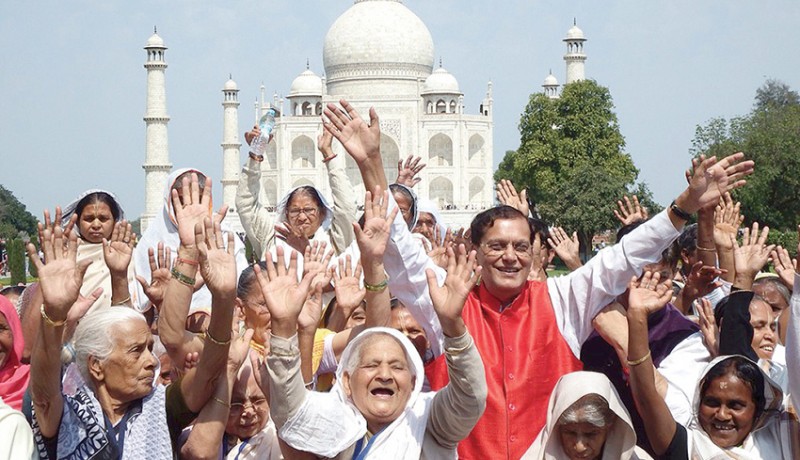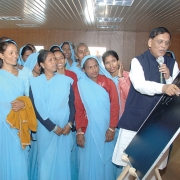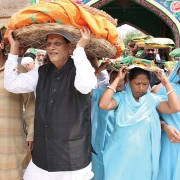
People

Dr Bindeshwar Pathak, a social reformer and designer of the Sulabh Shauchalya, has carried on the legacy of Mahatma Gandhi and Dr B R Ambedkar, reports Suparna-Saraswati Puri
Just like my wife gave birth to our three children, I also became pregnant and gave birth to Sulabh,” says Dr Bindeshwar Pathak, founder, Sulabh International Social Service Organisation. His act of love was born of gut-wrenching experiences in his early years, when he repeatedly witnessed the pitiable treatment meted out to ‘untouchables’, the ‘lowest of the low’ in the Indian caste system. These experiences prompted Pathak to commit his life to liberating the people Mahatma Gandhi had called ‘Harijans’, whose sole purpose, it would seem, was to pick up night soil, carry it in buckets on their heads and transport it to dumping grounds.
“When I started work in the late 1960s, nobody would come near the untouchables, although people would gladly play with a dog. The untouchables were doing valuable work for society and, in lieu of this, they were handed down cruel resentment and humiliation,” says the 73 year-old, New Delhi-based humanist, who was born into a Brahmin family in Bihar. Pathak’s aching conscience drove him to become a visionary and reformer—and, eventually, founder of Sulabh International in 1970. Pathak realised he could use the humble toilet as a powerful tool for social change. He figured that by rooting out manual scavenging, the very practice that relegated ‘untouchables’ to the fringes of society, he could facilitate their assimilation into the mainstream.
Pathak designed the two-pit, pour-flush toilet technology that revolutionised sanitation in India—in one fell swoop, ‘Sulabh Shauchalya’ eliminated the need to manually collect and clear away night soil. In time, it helped change the perception of ‘untouchables’, gave them respect and paved the way for their integration into society. In fact, in the past 46 years, Pathak’s Sulabh International has built 1.3 million household toilets and 54 million government toilets based on his pioneering design. Almost 15 million people across India use these facilities every day.
With liberating all communities becoming its new mission, Sulabh has since gone on to promote human rights, environmental sanitation, unconventional sources of energy, waste management, social reforms through education, women’s empowerment and community health and hygiene. Naturally, Pathak has won many awards and accolades for his body of work, the latest being the declaration of 14 April as ‘Dr Bindeshwar Pathak Day’ by the Mayor of New York.
In an exclusive interview, Dr Bindeshwar Pathak reveals how sanitation and social reform go hand in hand.
EXCERPTS FROM THE CONVERSATION
How did your family react to your choice of work?
I faced strong opposition because of my caste. It was very difficult for a Brahmin to work for untouchables at that time—they were poles apart in the India in which I grew up. I decided to live in a colony of scavenging untouchables in Bettiah town in the district of Champaran in Bihar. The idea was to see firsthand their pains and problems. While I was in the colony, I was in two minds about whether to continue this work as I faced tremendous opposition from my community. They were boiling with rage at my choice of ‘dirty work’. Despite this, I stayed.
What were the first steps you took in your mission?
My early inspiration came in 1968, when I joined the Bhangi-Mukti (scavengers’ liberation) Cell of the Bihar Gandhi Centenary Celebrations Committee. I lived in Bettiah to witness what it was really like to be forced to pick up human excreta and be shunned by society. Cruelly ostracised, their children lived in isolation and played only with pigs or among themselves. Their living conditions were hellish.
Were there any incidents that strengthened your conviction to take up this vocation?
I vividly recall two of them. One morning, I heard a hue and cry in the neighbourhood. A newly married girl was crying bitterly as she was being forced by her husband and in-laws to go to the town to clean the bucket toilets. When I intervened, her mother-in-law retorted sharply, ‘This is our profession. If she doesn’t do this, what will she do? If she sells vegetables, who will buy from her hands? She is destined to do this her whole life.’ At that time, I had no answer.
The second incident occurred one afternoon, when I was going to the market to have a cup of tea with some friends. We saw a boy wearing a red shirt being attacked by a bull. People did not make a move to save him as somebody in the crowd shouted that he belonged to the untouchable colony. My friends and I took the injured boy to the local hospital but the boy died. The incident shook me to my core. I forgot my family, my caste, my community, and I took a solemn vow to fulfil the dream of Mahatma Gandhi to rescue the untouchables from the shackles of slavery.
Apart from Sulabh’s toilet, what other tools have you used?
I adopted two towns in Rajasthan, Alwar and Tonk, as model towns to show that untouchables can be accepted by society. There I converted all the bucket toilets into Sulabh flush toilets and started giving the untouchables an education. Now they can read, write and sign their names. They are also engaged in making papadum, pickles, noodles and carpet weaving. They earn ₹ 15,000-20,000 per month as opposed to the ₹ 200-300 they used to earn while cleaning night soil. I have taken them to many temples and even for a dip in the Holy Ganges. I have helped them mix with the elite class and now they have access to, say, five-star hotels. Some are even giving facials to women in the same families where they used to go to clean night soil. I have fulfilled the four indicators of Dr B R Ambedkar, who dreamt of a scenario where all people would go together to worship in the temple, take a bath in the same pond, draw water from same well and share the same meal.
How far do you think you have come in rooting out ‘untouchability’ in India?
We are inching towards our goal of social acceptance as some villages have been established where untouchability is no longer practised—there is no manual cleaning of toilets and, most important, people from the once-untouchable community have found new vocations.
Whom did you focus on next?
After untouchables, the focus has been the widows of Vrindavan, Varanasi and Uttarakhand. Earlier, widows were not allowed to wear coloured clothes or ornaments, nor allowed to sing, dance or celebrate festivals. Now they celebrate Holi and Diwali; they participate in all social functions and festivals. This has helped change the attitude of the widows as well society. The widows are now willing to wear colourful clothes. We are showing them that they should live life as normal people. They should not be stigmatised as inauspicious. Earlier they wanted to die; now, they want to live their life.
What were the biggest challenges you have faced in your work spanning four decades?
The biggest challenge was that I am a Brahmin by caste. My father and father-in-law were opposed to my work for the untouchables. The second challenge was the development of technology. I am not an engineer; yet, the use of technology was the only way to bring about change. Third, there were financial issues growing up. We had to miss meals many a night, had no proper clothes to wear and were not able to pay our school fees on time. But it did not deter me from going ahead. There have been times when I have travelled extensively on foot and slept on railway platforms, sold my ancestral land and my wife’s ornaments to take the mission forward. There have been moments of utter hopelessness when I have even considered extreme steps like taking my own life. My challenges are beyond description but after starting my work, I became successful.
Tell us about some of your recent technological innovations.
Besides the two-pit ecologically compatible compost toilet technology and excreta-based biogas plant, we have also devised the Sulabh Effluent Treatment (SET) technology. The treated waste water is rendered colourless, odourless and free of organic particles; it can be used for aquaculture, agriculture, gardening or discharge into any water body. In the area of providing potable water, treatment plants have been installed at Madhusudankati in North 24 Parganas District, Mayapur in Nadia district as well as in Murshidabad in Murshidabad district, where underground water has unacceptable levels of arsenic content. We have also installed ‘water ATMs’ in some toilet complexes in urban areas and they have proved useful.
What legislative changes have you been able to bring about?
I am very happy that what I had envisioned about 50 years ago has become a national priority. The Prime Minister has made it a priority to provide toilets to every house by 2019. There have been other achievements too. In 1980-81, I asked the Ministry of Home Affairs to include liberation of scavengers and their rehabilitation on a ‘whole-town approach’ basis. Under the scheme, towns in many different states were adopted. It was also decided that state governments shall provide alternative employment to liberated scavengers.
In 1986, it was my persistence with the Ministry of Welfare that led to the Protection of Civil Rights (PCR) Act, where stipends are given to the wards of Muslim and Christian scavengers as well for training and rehabilitation. Earlier, these were available only to Hindu scavengers. Further, Sulabh has set up an English-medium school in New Delhi for the children of the scavengers.
What made you set up the Sulabh International Museum of Toilets?
Motivated by a visit to Madam Tussaud’s in London, I built the museum in 1994. Located at Palam in New Delhi, it has a number of unique exhibits, like the oldest WC toilet from Harappan settlements dating back to 2,500 BC; the throne-like chamber pot of the French Emperor, Louis XIV, who while using it simultaneously gave an audience to select people; and even a bookshelf-type toilet from France bearing the name of an English classic embossed on its rim, intended to humiliate the British and hinting at their traditional cultural animosity.
What does a day in your life look like? How do you relax?
I immerse myself in work relating to sanitation 24×7. Thinking up ways to improve sanitation is in itself a relaxing pursuit. I also occupy myself with thinking and reading about spiritual matters, which in ordinary parlance is called adhyatm. This provides me mental relaxation and helps my physical well-being too.
What is the roadmap ahead for Sulabh International?
We aim to build as many public toilets as possible with assistance from governments, local bodies and business houses. We are also working towards motivating 20 million NRIs to help achieve ‘Open-Defecation-Free India’ by 2019.
Photo courtesy: Sulabh International Featured in Harmony — Celebrate Age Magazine September 2016
you may also like to read
-
For the love of Sanskrit
During her 60s, if you had told Sushila A that she would be securing a doctorate in Sanskrit in the….
-
Style sensation
Meet Instagram star Moon Lin Cocking a snook at ageism, this nonagenarian Taiwanese woman is slaying street fashion like….
-
Beauty and her beast
Meet Instagram star Linda Rodin Most beauty and style influencers on Instagram hope to launch their beauty line someday…..
-
Cooking up a storm!
Meet Instagram star Shanthi Ramachandran In today’s web-fuelled world, you can now get recipes for your favourite dishes at….









